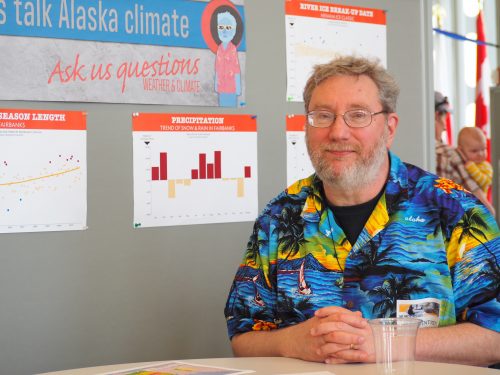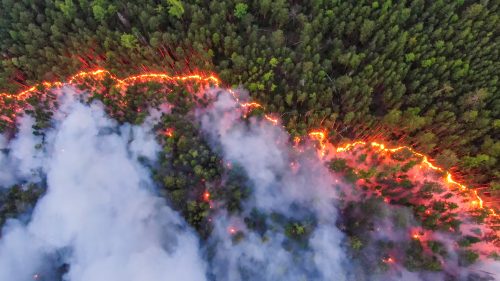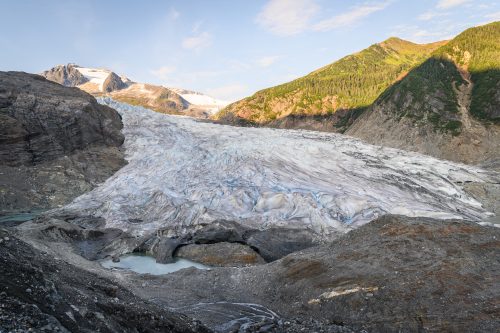Alaskan leads Arctic Report Card warning Arctic warming continues
December 8, 2020
Heather McFarland
907-474-6286

“Warmer, less frozen and biologically changed.” This is the new tagline used to describe the Arctic in the 2020 Arctic Report Card released this week by the National Oceanic and Atmospheric Administration.
According to Rick Thoman, this year’s lead editor and a climate specialist at the University of Alaska Fairbanks, the report has told the same story for the past decade. Thoman is part of the Alaska Center for Climate Assessment and Policy at UAF’s International Arctic Research Center.
The Arctic Report Card is produced annually to provide the latest information on all aspects of the Arctic environment. Since it is peer reviewed, clear, concise and extremely timely, the report has become the go-to place for scientists, media, decision-makers and the public to find reliable information.
This year’s report showed that although Alaskans experienced relatively normal conditions from October 2019 to September 2020, the Arctic as a whole saw the second-warmest October-to-September period since at least 1900. The heat was most apparent in Siberia, where tremendous warmth drove massive wildfires.
“What I think the Arctic Report Card is really good at, is showing that the big story is the same, but the regions differ year to year,” said Thoman.
As editor, Thoman coordinated submissions on temperature, snow, ice, vegetation, biology and other topics from 133 scientists in 15 countries. Many other Alaskans joined Thoman in the effort, including 15 additional UAF scientists.
Alison York, a wildfire expert at the International Arctic Research Center, led the report’s wildfire section. She used her connections as coordinator of the Alaska Fire Science Consortium to assemble a circumpolar team of wildfire experts.

The team described the recent increase in wildfire activity in the Arctic. In 2018, Sweden saw an eight-fold increase in wildfire activity. The following year, the fire hotspot shifted to North America, where more than half the acres burned in the United States were in Alaska. This past summer, an area the size of Greece burned in Siberia.
“Over the past 20 years there has been an unusually large fire season or fire event somewhere in the circumpolar north almost every year,” said York. “It’s always somewhere.”
Gabriel Wolken, from the International Arctic Research Center and the Alaska Division of Geological and Geophysical Surveys, has contributed to the glaciers and ice caps section of the report card for over a decade. This year, his section highlighted the enormous glacier melt that occurred during 2018 and 2019, a continuing trend.
“This is significant in the sense that while Arctic glaciers and ice caps are relatively small compared to the ice sheet, they are contributing disproportionately to sea level rise,” said Wolken. “Right now, it’s Alaska that is leading that charge.”
With some sections updated just minutes before release, the Arctic Report Card differs from the relatively slow and cautious pace science usually takes.
“It’s an incredible sprint,” said Thoman. The report’s real-time data is critical to making decisions in response to the rapid changes happening in Alaska and across the Arctic, he said.
Learn more by participating in an Alaska-focused webinar with several UAF contributors to the Arctic Report Card on Dec. 15 at 10 a.m. Alaska time.

Additional UAF-based contributors to the Arctic Report Card include Tom Ballinger, Uma Bhatt, Louise Farquharson, Zav Grabinski, Ben Jones, Chris Maio, Martha Raynolds, Jackie Richter-Menge, Vladimir Romanovsky, Skip Walker, John Walsh, Melinda Webster and Robert Ziel.
ADDITIONAL CONTACTS: Rick Thoman, rthoman@alaska.edu, 907-474-2415; Alison York, ayork@alaska.edu, 907-322-7176; Gabriel Wolken, gabriel.wolken@alaska.gov; Tom Ballinger, tjballinger@alaska.edu


